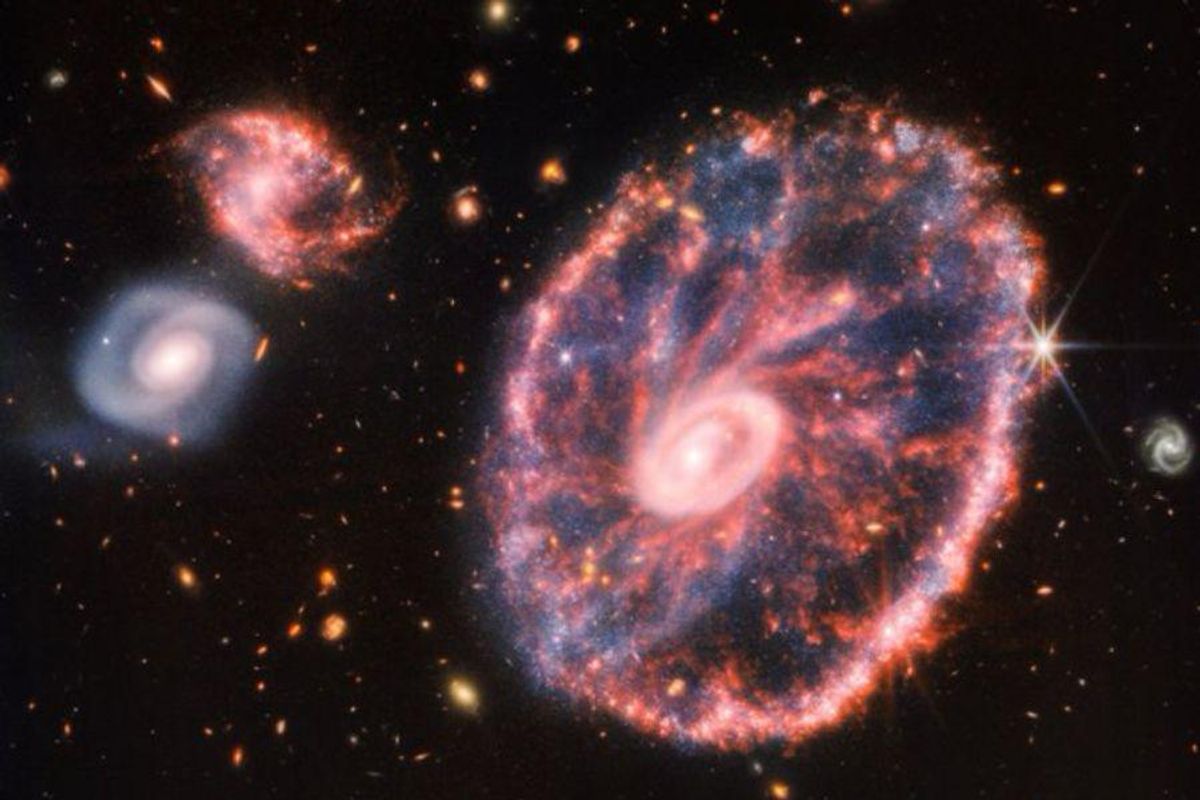
When the first images of space came back from the high-powered James Webb Space Telescope on July 12, 2022, it felt like the whole world stopped for a moment to marvel. Never before have we seen such an intricate look at what’s out there, and the detail was stunning. Since then, we’ve seen a steady stream of visual wonders far beyond our solar system, delighting our eyes and tickling our imaginations.
But what about those who aren’t able to see them? Do people who are visually impaired simply miss out on the joy of “seeing” these gorgeous glimpses of our universe?
Nope. NASA has made sure that these images are accessible to all and has done a stellar job of it. The alt text descriptions of the Webb telescope images are truly wonderful, giving not only visual descriptions but additional details that all of us can benefit from.
For instance, here’s a recent alt text description from one of the Webb telescope images:
“A dramatic blade made of red gaseous wisps comes down top-to-bottom in the center of the image as smaller green wisps feather out in horizontal directions. A bright star shrouded in blue light is near the center of the bow-like blade. Blue dots in different sizes dot the background of the image, signifying neighboring stars.”
And here’s the image it’s describing:
u201cA powerful stellar explosion from a nearby star propelled Zeta Ophiuchi about 100,000 mph (160,934 km). Data from @ChandraXray shows a bubble of X-ray emission (blue) around the star is produced by gas that has been heated to tens of millions of degrees: https://t.co/bsJZAp6kKwu201d— NASA (@NASA)
1659039589
Or check out this image of the Cartwheel Galaxy and the way the alt text describes it.
u201cWebb is on a roll! ud83eudd38nnThis new @NASAWebb near and mid-infrared composite image highlights the Cartwheel Galaxy, the result of a high-speed collision that occurred about 440 million years ago, along with two neighboring galaxies. Get the details: https://t.co/c8lEVBBlubu201d— NASA (@NASA)
1659449558
“Image Description: A large galaxy on the right, with two much smaller companion galaxies to the left at 10 o’clock and 9 o’clock. The large galaxy resembles a speckled wheel, with an oval outer ring and a small, off-center inner ring. The outer ring contains pink plumes like wheel spokes, with dusty blue regions in between. The pink areas are silicate dust, while the blue areas are pockets of young stars and hydrocarbon dust. The inner ring is smoother, filled in with a more uniform pale pink. This smaller ring is interwoven with thin, orange-pink threads. On the galaxy’s right edge, a bright white star with 8 diffraction spikes shines. The two companion galaxies to the left, one above the other, are about the same size and both spiral galaxies. The galaxy above is a reverse S shape but similar in coloring and texture as the large ring galaxy. The galaxy below is smoother and largely white, with a blue tinge. The background is black and full of more distant, orange-red colored galaxies of various sizes.”
Alt text is often brief and concise, offering enough description to get a general idea of what an image is but not a ton of detail. Such brevity is helpful in certain contexts, but not when you’re describing awe-inspiring pictures of the deep universe.
According to an article by Theresa Vargas in The Washington Post, the descriptions come from a team of writers, designers, educators and scientists at the Space Telescope Science Institute in Baltimore.
“It’s been really heartening to see how much this has touched people,” Tim Rhue II, principal informal education specialist at the institute, told the Post. “It’s something that’s deeply personal to so many people. On top of that, we do it because we want to make astronomy accessible to everyone. It’s astronomy and dinosaurs that are gateways to science for so many people.”
In an interview with NPR, Rhue described creating the alt text descriptions as “a labor of love.”
“Space is for everyone,” he said. “It shouldn’t matter who you are.”
NASA’s alt text descriptions not only make the images accessible to everyone, but they make the science of the images more accessible for everyone. Even those without visual impairments can appreciate reading the scientific detail of what makes certain colors or shapes in the images. The team at the Space Telescope Science Institute goes out of its way to include lots of detail, going beyond simple surface descriptions. It matters, and it’s being noticed by people of all abilities.
Thank you, NASA, for illustrating the fact that when we embrace greater accessibility, we all win.
